BIM Education Challenges in UK Higher Education - March 2015
VerifiedAdded on 2023/04/06
|47
|14451
|370
Report
AI Summary
This report, supported by the BIM Task Group and the Higher Education Academy, presents a comprehensive analysis of the current position and associated challenges of Building Information Modeling (BIM) education in UK Higher Education. The study, conducted by the BIM Academic Forum, assesses key areas including staff resources, the state of BIM implementation, BIM adoption strategies, awareness levels, and generation-related implications. The findings reveal varying levels of BIM readiness across UK HEIs, highlighting disparities between top and low performers, and the need for improved industry engagement. A BIM assessment matrix is developed, offering updated requirements for BIM teaching and strategic considerations. The report emphasizes the need for HEIs to adapt to the evolving demands of the construction industry and the digital revolution, providing insights into software adoption, curriculum integration, and the impact of generational differences on BIM adoption.

March 2015
Professor Jason Underwood
Dr Oladotun Ayoade
Current Position and Associated
Challenges of BIM Education in UK
Higher Education
Professor Jason Underwood
Dr Oladotun Ayoade
Current Position and Associated
Challenges of BIM Education in UK
Higher Education
Paraphrase This Document
Need a fresh take? Get an instant paraphrase of this document with our AI Paraphraser
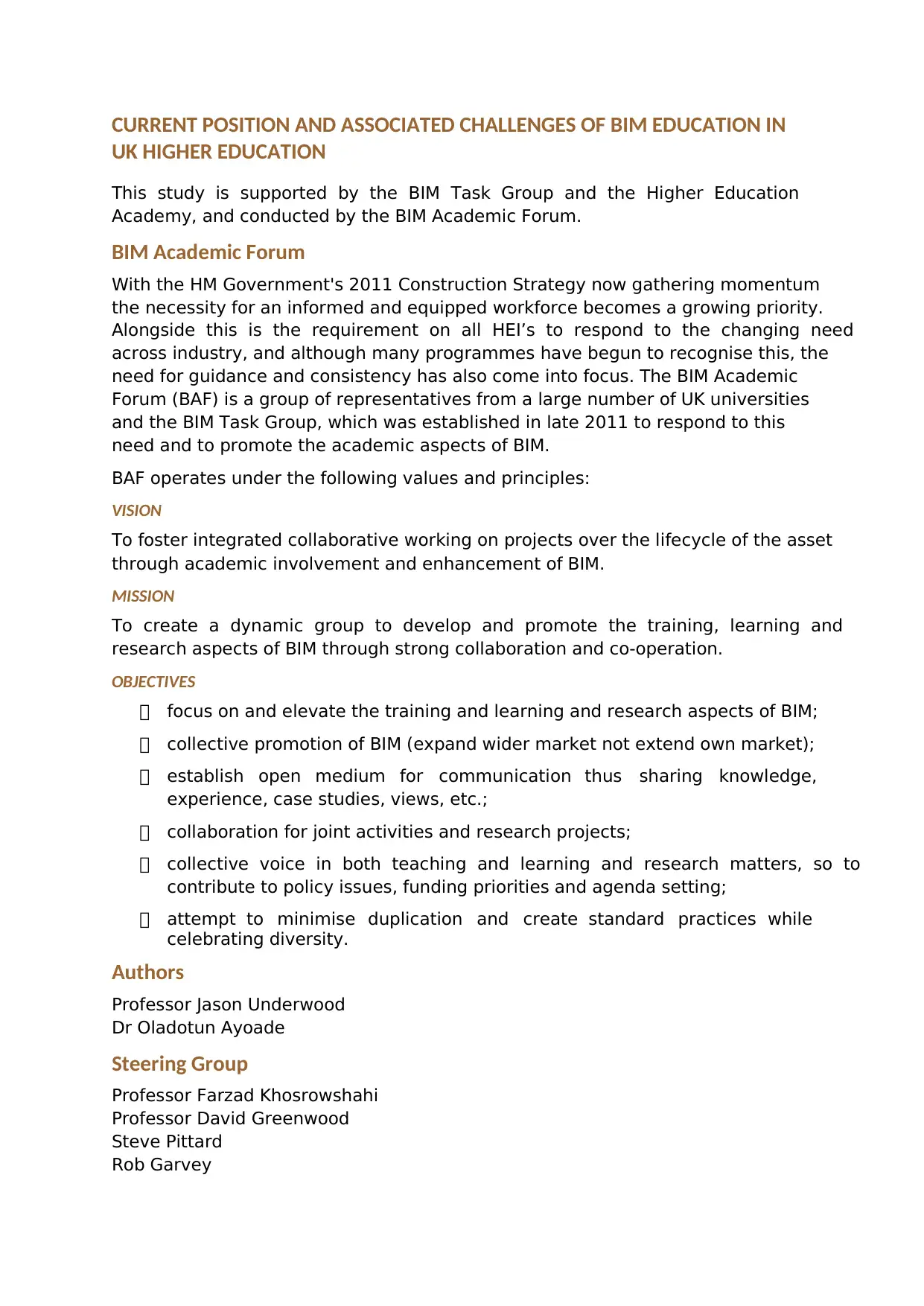
CURRENT POSITION AND ASSOCIATED CHALLENGES OF BIM EDUCATION IN
UK HIGHER EDUCATION
This study is supported by the BIM Task Group and the Higher Education
Academy, and conducted by the BIM Academic Forum.
BIM Academic Forum
With the HM Government's 2011 Construction Strategy now gathering momentum
the necessity for an informed and equipped workforce becomes a growing priority.
Alongside this is the requirement on all HEI’s to respond to the changing need
across industry, and although many programmes have begun to recognise this, the
need for guidance and consistency has also come into focus. The BIM Academic
Forum (BAF) is a group of representatives from a large number of UK universities
and the BIM Task Group, which was established in late 2011 to respond to this
need and to promote the academic aspects of BIM.
BAF operates under the following values and principles:
VISION
To foster integrated collaborative working on projects over the lifecycle of the asset
through academic involvement and enhancement of BIM.
MISSION
To create a dynamic group to develop and promote the training, learning and
research aspects of BIM through strong collaboration and co-operation.
OBJECTIVES
focus on and elevate the training and learning and research aspects of BIM;
collective promotion of BIM (expand wider market not extend own market);
establish open medium for communication thus sharing knowledge,
experience, case studies, views, etc.;
collaboration for joint activities and research projects;
collective voice in both teaching and learning and research matters, so to
contribute to policy issues, funding priorities and agenda setting;
attempt to minimise duplication and create standard practices while
celebrating diversity.
Authors
Professor Jason Underwood
Dr Oladotun Ayoade
Steering Group
Professor Farzad Khosrowshahi
Professor David Greenwood
Steve Pittard
Rob Garvey
UK HIGHER EDUCATION
This study is supported by the BIM Task Group and the Higher Education
Academy, and conducted by the BIM Academic Forum.
BIM Academic Forum
With the HM Government's 2011 Construction Strategy now gathering momentum
the necessity for an informed and equipped workforce becomes a growing priority.
Alongside this is the requirement on all HEI’s to respond to the changing need
across industry, and although many programmes have begun to recognise this, the
need for guidance and consistency has also come into focus. The BIM Academic
Forum (BAF) is a group of representatives from a large number of UK universities
and the BIM Task Group, which was established in late 2011 to respond to this
need and to promote the academic aspects of BIM.
BAF operates under the following values and principles:
VISION
To foster integrated collaborative working on projects over the lifecycle of the asset
through academic involvement and enhancement of BIM.
MISSION
To create a dynamic group to develop and promote the training, learning and
research aspects of BIM through strong collaboration and co-operation.
OBJECTIVES
focus on and elevate the training and learning and research aspects of BIM;
collective promotion of BIM (expand wider market not extend own market);
establish open medium for communication thus sharing knowledge,
experience, case studies, views, etc.;
collaboration for joint activities and research projects;
collective voice in both teaching and learning and research matters, so to
contribute to policy issues, funding priorities and agenda setting;
attempt to minimise duplication and create standard practices while
celebrating diversity.
Authors
Professor Jason Underwood
Dr Oladotun Ayoade
Steering Group
Professor Farzad Khosrowshahi
Professor David Greenwood
Steve Pittard
Rob Garvey
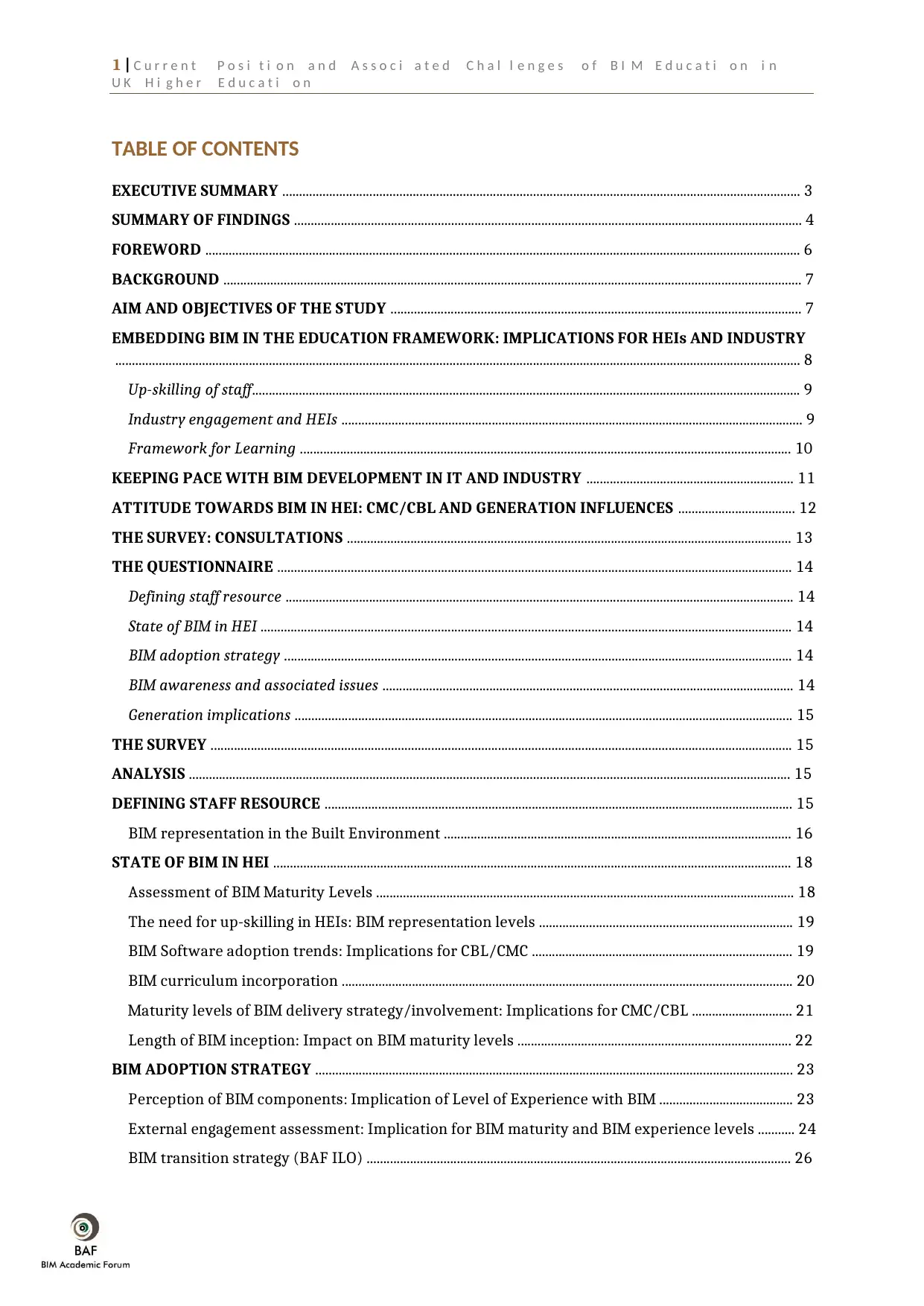
1 | C u r r e n t P o s i t i o n a n d A s s o c i a t e d C h a l l e n g e s o f B I M E d u c a t i o n i n
U K H i g h e r E d u c a t i o n
TABLE OF CONTENTS
EXECUTIVE SUMMARY ........................................................................................................................................................... 3
SUMMARY OF FINDINGS ........................................................................................................................................................ 4
FOREWORD .................................................................................................................................................................................. 6
BACKGROUND ............................................................................................................................................................................. 7
AIM AND OBJECTIVES OF THE STUDY ........................................................................................................................... 7
EMBEDDING BIM IN THE EDUCATION FRAMEWORK: IMPLICATIONS FOR HEIs AND INDUSTRY
............................................................................................................................................................................................................. 8
Up-skilling of staff.................................................................................................................................................................... 9
Industry engagement and HEIs .......................................................................................................................................... 9
Framework for Learning ................................................................................................................................................... 10
KEEPING PACE WITH BIM DEVELOPMENT IN IT AND INDUSTRY .............................................................. 11
ATTITUDE TOWARDS BIM IN HEI: CMC/CBL AND GENERATION INFLUENCES ................................... 12
THE SURVEY: CONSULTATIONS ..................................................................................................................................... 13
THE QUESTIONNAIRE .......................................................................................................................................................... 14
Defining staff resource ........................................................................................................................................................ 14
State of BIM in HEI ............................................................................................................................................................... 14
BIM adoption strategy ........................................................................................................................................................ 14
BIM awareness and associated issues ........................................................................................................................... 14
Generation implications ..................................................................................................................................................... 15
THE SURVEY .............................................................................................................................................................................. 15
ANALYSIS .................................................................................................................................................................................... 15
DEFINING STAFF RESOURCE ............................................................................................................................................ 15
BIM representation in the Built Environment ........................................................................................................ 16
STATE OF BIM IN HEI ........................................................................................................................................................... 18
Assessment of BIM Maturity Levels ............................................................................................................................. 18
The need for up-skilling in HEIs: BIM representation levels ............................................................................ 19
BIM Software adoption trends: Implications for CBL/CMC .............................................................................. 19
BIM curriculum incorporation ....................................................................................................................................... 20
Maturity levels of BIM delivery strategy/involvement: Implications for CMC/CBL .............................. 21
Length of BIM inception: Impact on BIM maturity levels .................................................................................. 22
BIM ADOPTION STRATEGY ............................................................................................................................................... 23
Perception of BIM components: Implication of Level of Experience with BIM ........................................ 23
External engagement assessment: Implication for BIM maturity and BIM experience levels ........... 24
BIM transition strategy (BAF ILO) ............................................................................................................................... 26
U K H i g h e r E d u c a t i o n
TABLE OF CONTENTS
EXECUTIVE SUMMARY ........................................................................................................................................................... 3
SUMMARY OF FINDINGS ........................................................................................................................................................ 4
FOREWORD .................................................................................................................................................................................. 6
BACKGROUND ............................................................................................................................................................................. 7
AIM AND OBJECTIVES OF THE STUDY ........................................................................................................................... 7
EMBEDDING BIM IN THE EDUCATION FRAMEWORK: IMPLICATIONS FOR HEIs AND INDUSTRY
............................................................................................................................................................................................................. 8
Up-skilling of staff.................................................................................................................................................................... 9
Industry engagement and HEIs .......................................................................................................................................... 9
Framework for Learning ................................................................................................................................................... 10
KEEPING PACE WITH BIM DEVELOPMENT IN IT AND INDUSTRY .............................................................. 11
ATTITUDE TOWARDS BIM IN HEI: CMC/CBL AND GENERATION INFLUENCES ................................... 12
THE SURVEY: CONSULTATIONS ..................................................................................................................................... 13
THE QUESTIONNAIRE .......................................................................................................................................................... 14
Defining staff resource ........................................................................................................................................................ 14
State of BIM in HEI ............................................................................................................................................................... 14
BIM adoption strategy ........................................................................................................................................................ 14
BIM awareness and associated issues ........................................................................................................................... 14
Generation implications ..................................................................................................................................................... 15
THE SURVEY .............................................................................................................................................................................. 15
ANALYSIS .................................................................................................................................................................................... 15
DEFINING STAFF RESOURCE ............................................................................................................................................ 15
BIM representation in the Built Environment ........................................................................................................ 16
STATE OF BIM IN HEI ........................................................................................................................................................... 18
Assessment of BIM Maturity Levels ............................................................................................................................. 18
The need for up-skilling in HEIs: BIM representation levels ............................................................................ 19
BIM Software adoption trends: Implications for CBL/CMC .............................................................................. 19
BIM curriculum incorporation ....................................................................................................................................... 20
Maturity levels of BIM delivery strategy/involvement: Implications for CMC/CBL .............................. 21
Length of BIM inception: Impact on BIM maturity levels .................................................................................. 22
BIM ADOPTION STRATEGY ............................................................................................................................................... 23
Perception of BIM components: Implication of Level of Experience with BIM ........................................ 23
External engagement assessment: Implication for BIM maturity and BIM experience levels ........... 24
BIM transition strategy (BAF ILO) ............................................................................................................................... 26
⊘ This is a preview!⊘
Do you want full access?
Subscribe today to unlock all pages.

Trusted by 1+ million students worldwide
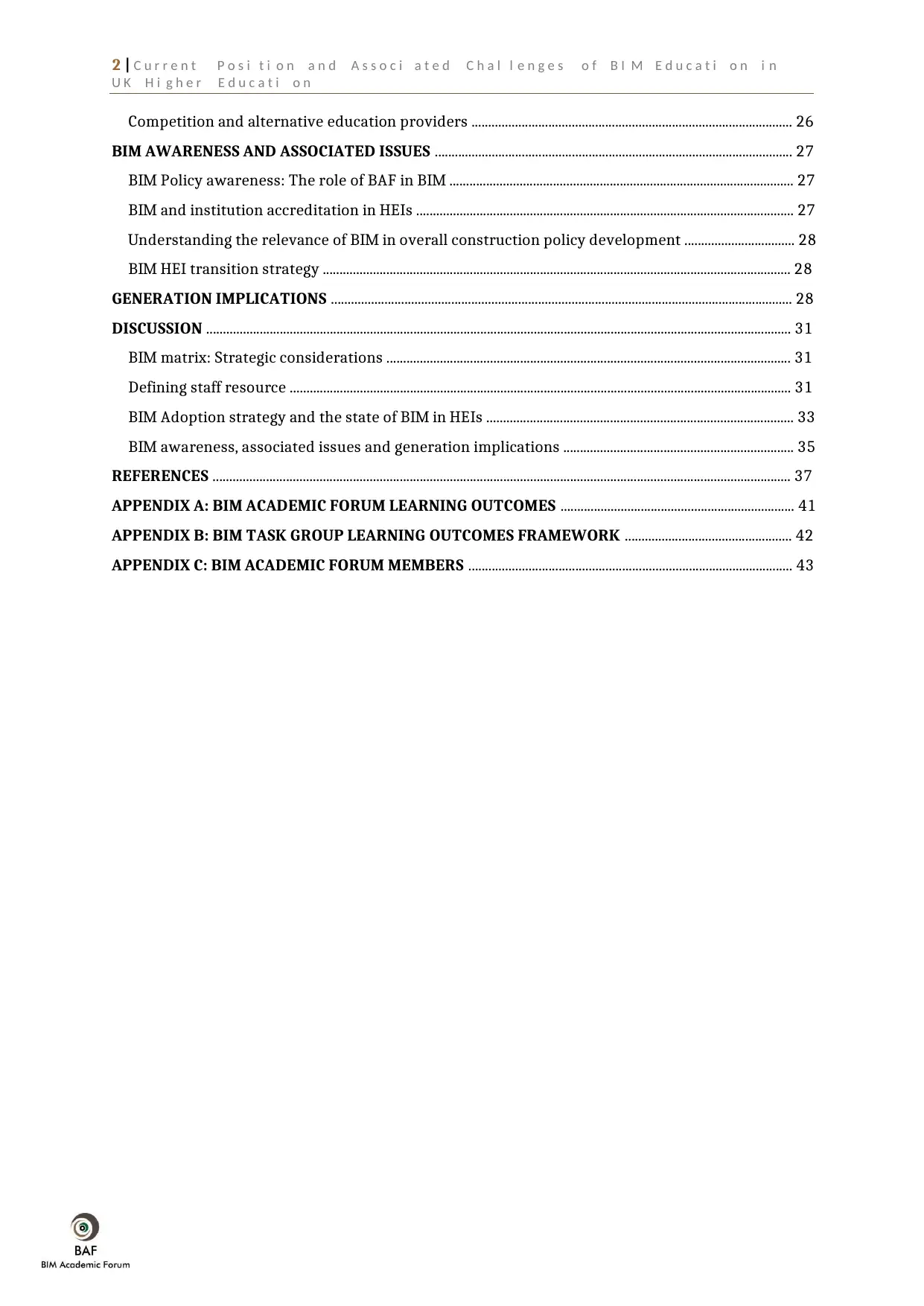
2 | C u r r e n t P o s i t i o n a n d A s s o c i a t e d C h a l l e n g e s o f B I M E d u c a t i o n i n
U K H i g h e r E d u c a t i o n
Competition and alternative education providers ................................................................................................ 26
BIM AWARENESS AND ASSOCIATED ISSUES ........................................................................................................... 27
BIM Policy awareness: The role of BAF in BIM ....................................................................................................... 27
BIM and institution accreditation in HEIs ................................................................................................................. 27
Understanding the relevance of BIM in overall construction policy development ................................. 28
BIM HEI transition strategy ............................................................................................................................................ 28
GENERATION IMPLICATIONS .......................................................................................................................................... 28
DISCUSSION ............................................................................................................................................................................... 31
BIM matrix: Strategic considerations ......................................................................................................................... 31
Defining staff resource ...................................................................................................................................................... 31
BIM Adoption strategy and the state of BIM in HEIs ............................................................................................ 33
BIM awareness, associated issues and generation implications ..................................................................... 35
REFERENCES ............................................................................................................................................................................. 37
APPENDIX A: BIM ACADEMIC FORUM LEARNING OUTCOMES ...................................................................... 41
APPENDIX B: BIM TASK GROUP LEARNING OUTCOMES FRAMEWORK .................................................. 42
APPENDIX C: BIM ACADEMIC FORUM MEMBERS ................................................................................................. 43
U K H i g h e r E d u c a t i o n
Competition and alternative education providers ................................................................................................ 26
BIM AWARENESS AND ASSOCIATED ISSUES ........................................................................................................... 27
BIM Policy awareness: The role of BAF in BIM ....................................................................................................... 27
BIM and institution accreditation in HEIs ................................................................................................................. 27
Understanding the relevance of BIM in overall construction policy development ................................. 28
BIM HEI transition strategy ............................................................................................................................................ 28
GENERATION IMPLICATIONS .......................................................................................................................................... 28
DISCUSSION ............................................................................................................................................................................... 31
BIM matrix: Strategic considerations ......................................................................................................................... 31
Defining staff resource ...................................................................................................................................................... 31
BIM Adoption strategy and the state of BIM in HEIs ............................................................................................ 33
BIM awareness, associated issues and generation implications ..................................................................... 35
REFERENCES ............................................................................................................................................................................. 37
APPENDIX A: BIM ACADEMIC FORUM LEARNING OUTCOMES ...................................................................... 41
APPENDIX B: BIM TASK GROUP LEARNING OUTCOMES FRAMEWORK .................................................. 42
APPENDIX C: BIM ACADEMIC FORUM MEMBERS ................................................................................................. 43
Paraphrase This Document
Need a fresh take? Get an instant paraphrase of this document with our AI Paraphraser
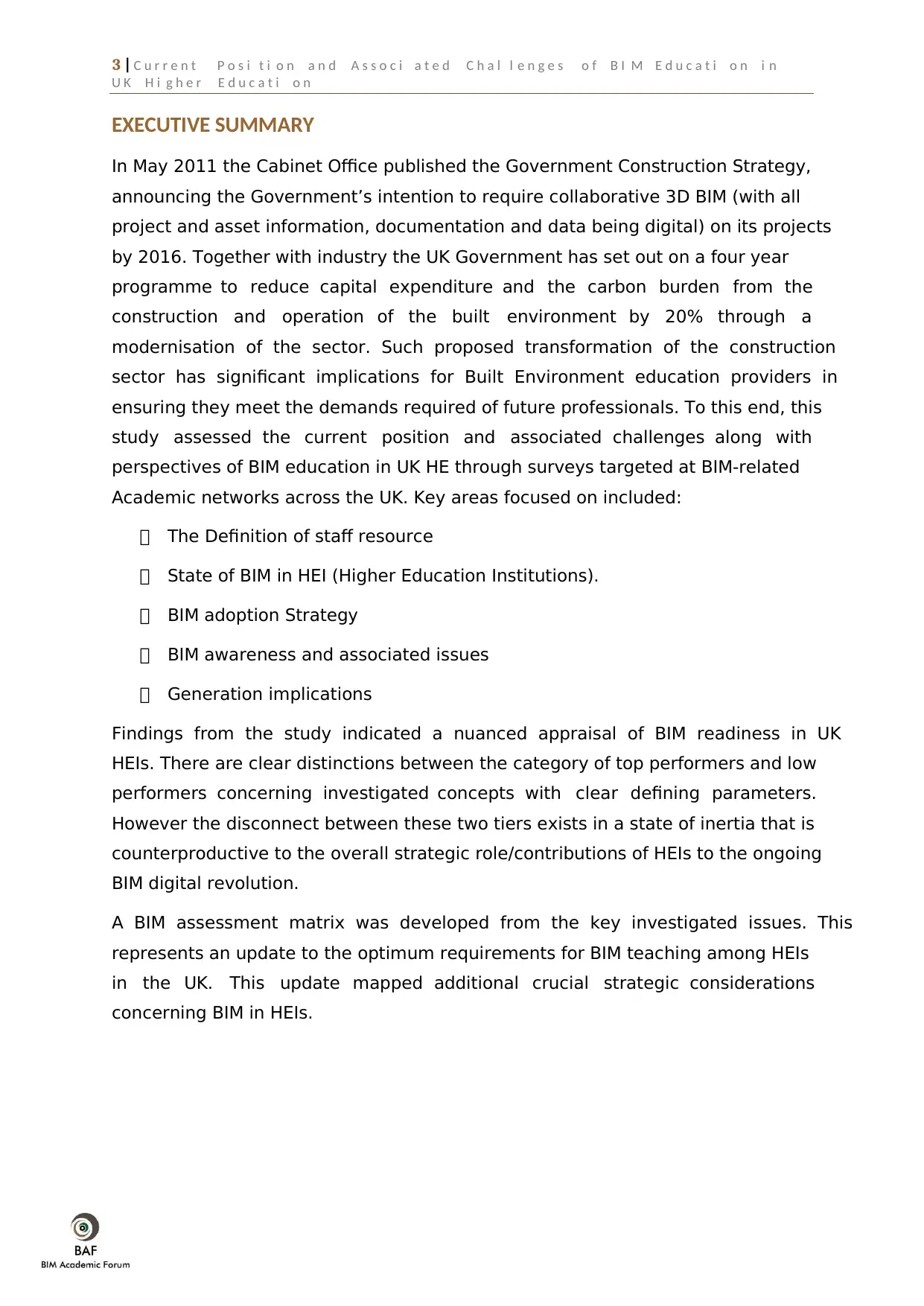
3 | C u r r e n t P o s i t i o n a n d A s s o c i a t e d C h a l l e n g e s o f B I M E d u c a t i o n i n
U K H i g h e r E d u c a t i o n
EXECUTIVE SUMMARY
In May 2011 the Cabinet Office published the Government Construction Strategy,
announcing the Government’s intention to require collaborative 3D BIM (with all
project and asset information, documentation and data being digital) on its projects
by 2016. Together with industry the UK Government has set out on a four year
programme to reduce capital expenditure and the carbon burden from the
construction and operation of the built environment by 20% through a
modernisation of the sector. Such proposed transformation of the construction
sector has significant implications for Built Environment education providers in
ensuring they meet the demands required of future professionals. To this end, this
study assessed the current position and associated challenges along with
perspectives of BIM education in UK HE through surveys targeted at BIM-related
Academic networks across the UK. Key areas focused on included:
The Definition of staff resource
State of BIM in HEI (Higher Education Institutions).
BIM adoption Strategy
BIM awareness and associated issues
Generation implications
Findings from the study indicated a nuanced appraisal of BIM readiness in UK
HEIs. There are clear distinctions between the category of top performers and low
performers concerning investigated concepts with clear defining parameters.
However the disconnect between these two tiers exists in a state of inertia that is
counterproductive to the overall strategic role/contributions of HEIs to the ongoing
BIM digital revolution.
A BIM assessment matrix was developed from the key investigated issues. This
represents an update to the optimum requirements for BIM teaching among HEIs
in the UK. This update mapped additional crucial strategic considerations
concerning BIM in HEIs.
U K H i g h e r E d u c a t i o n
EXECUTIVE SUMMARY
In May 2011 the Cabinet Office published the Government Construction Strategy,
announcing the Government’s intention to require collaborative 3D BIM (with all
project and asset information, documentation and data being digital) on its projects
by 2016. Together with industry the UK Government has set out on a four year
programme to reduce capital expenditure and the carbon burden from the
construction and operation of the built environment by 20% through a
modernisation of the sector. Such proposed transformation of the construction
sector has significant implications for Built Environment education providers in
ensuring they meet the demands required of future professionals. To this end, this
study assessed the current position and associated challenges along with
perspectives of BIM education in UK HE through surveys targeted at BIM-related
Academic networks across the UK. Key areas focused on included:
The Definition of staff resource
State of BIM in HEI (Higher Education Institutions).
BIM adoption Strategy
BIM awareness and associated issues
Generation implications
Findings from the study indicated a nuanced appraisal of BIM readiness in UK
HEIs. There are clear distinctions between the category of top performers and low
performers concerning investigated concepts with clear defining parameters.
However the disconnect between these two tiers exists in a state of inertia that is
counterproductive to the overall strategic role/contributions of HEIs to the ongoing
BIM digital revolution.
A BIM assessment matrix was developed from the key investigated issues. This
represents an update to the optimum requirements for BIM teaching among HEIs
in the UK. This update mapped additional crucial strategic considerations
concerning BIM in HEIs.
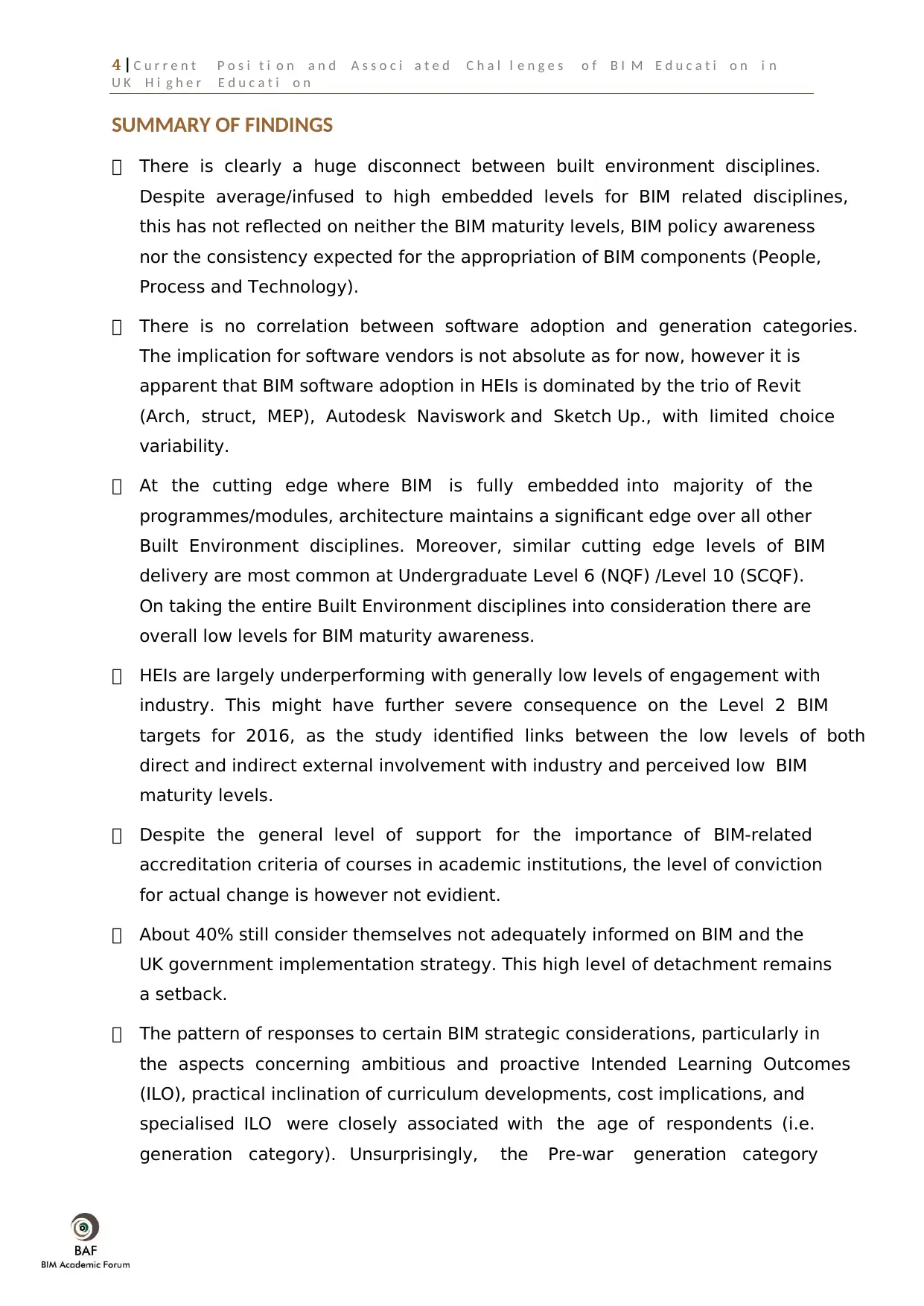
4 | C u r r e n t P o s i t i o n a n d A s s o c i a t e d C h a l l e n g e s o f B I M E d u c a t i o n i n
U K H i g h e r E d u c a t i o n
SUMMARY OF FINDINGS
There is clearly a huge disconnect between built environment disciplines.
Despite average/infused to high embedded levels for BIM related disciplines,
this has not reflected on neither the BIM maturity levels, BIM policy awareness
nor the consistency expected for the appropriation of BIM components (People,
Process and Technology).
There is no correlation between software adoption and generation categories.
The implication for software vendors is not absolute as for now, however it is
apparent that BIM software adoption in HEIs is dominated by the trio of Revit
(Arch, struct, MEP), Autodesk Naviswork and Sketch Up., with limited choice
variability.
At the cutting edge where BIM is fully embedded into majority of the
programmes/modules, architecture maintains a significant edge over all other
Built Environment disciplines. Moreover, similar cutting edge levels of BIM
delivery are most common at Undergraduate Level 6 (NQF) /Level 10 (SCQF).
On taking the entire Built Environment disciplines into consideration there are
overall low levels for BIM maturity awareness.
HEIs are largely underperforming with generally low levels of engagement with
industry. This might have further severe consequence on the Level 2 BIM
targets for 2016, as the study identified links between the low levels of both
direct and indirect external involvement with industry and perceived low BIM
maturity levels.
Despite the general level of support for the importance of BIM-related
accreditation criteria of courses in academic institutions, the level of conviction
for actual change is however not evidient.
About 40% still consider themselves not adequately informed on BIM and the
UK government implementation strategy. This high level of detachment remains
a setback.
The pattern of responses to certain BIM strategic considerations, particularly in
the aspects concerning ambitious and proactive Intended Learning Outcomes
(ILO), practical inclination of curriculum developments, cost implications, and
specialised ILO were closely associated with the age of respondents (i.e.
generation category). Unsurprisingly, the Pre-war generation category
U K H i g h e r E d u c a t i o n
SUMMARY OF FINDINGS
There is clearly a huge disconnect between built environment disciplines.
Despite average/infused to high embedded levels for BIM related disciplines,
this has not reflected on neither the BIM maturity levels, BIM policy awareness
nor the consistency expected for the appropriation of BIM components (People,
Process and Technology).
There is no correlation between software adoption and generation categories.
The implication for software vendors is not absolute as for now, however it is
apparent that BIM software adoption in HEIs is dominated by the trio of Revit
(Arch, struct, MEP), Autodesk Naviswork and Sketch Up., with limited choice
variability.
At the cutting edge where BIM is fully embedded into majority of the
programmes/modules, architecture maintains a significant edge over all other
Built Environment disciplines. Moreover, similar cutting edge levels of BIM
delivery are most common at Undergraduate Level 6 (NQF) /Level 10 (SCQF).
On taking the entire Built Environment disciplines into consideration there are
overall low levels for BIM maturity awareness.
HEIs are largely underperforming with generally low levels of engagement with
industry. This might have further severe consequence on the Level 2 BIM
targets for 2016, as the study identified links between the low levels of both
direct and indirect external involvement with industry and perceived low BIM
maturity levels.
Despite the general level of support for the importance of BIM-related
accreditation criteria of courses in academic institutions, the level of conviction
for actual change is however not evidient.
About 40% still consider themselves not adequately informed on BIM and the
UK government implementation strategy. This high level of detachment remains
a setback.
The pattern of responses to certain BIM strategic considerations, particularly in
the aspects concerning ambitious and proactive Intended Learning Outcomes
(ILO), practical inclination of curriculum developments, cost implications, and
specialised ILO were closely associated with the age of respondents (i.e.
generation category). Unsurprisingly, the Pre-war generation category
⊘ This is a preview!⊘
Do you want full access?
Subscribe today to unlock all pages.

Trusted by 1+ million students worldwide
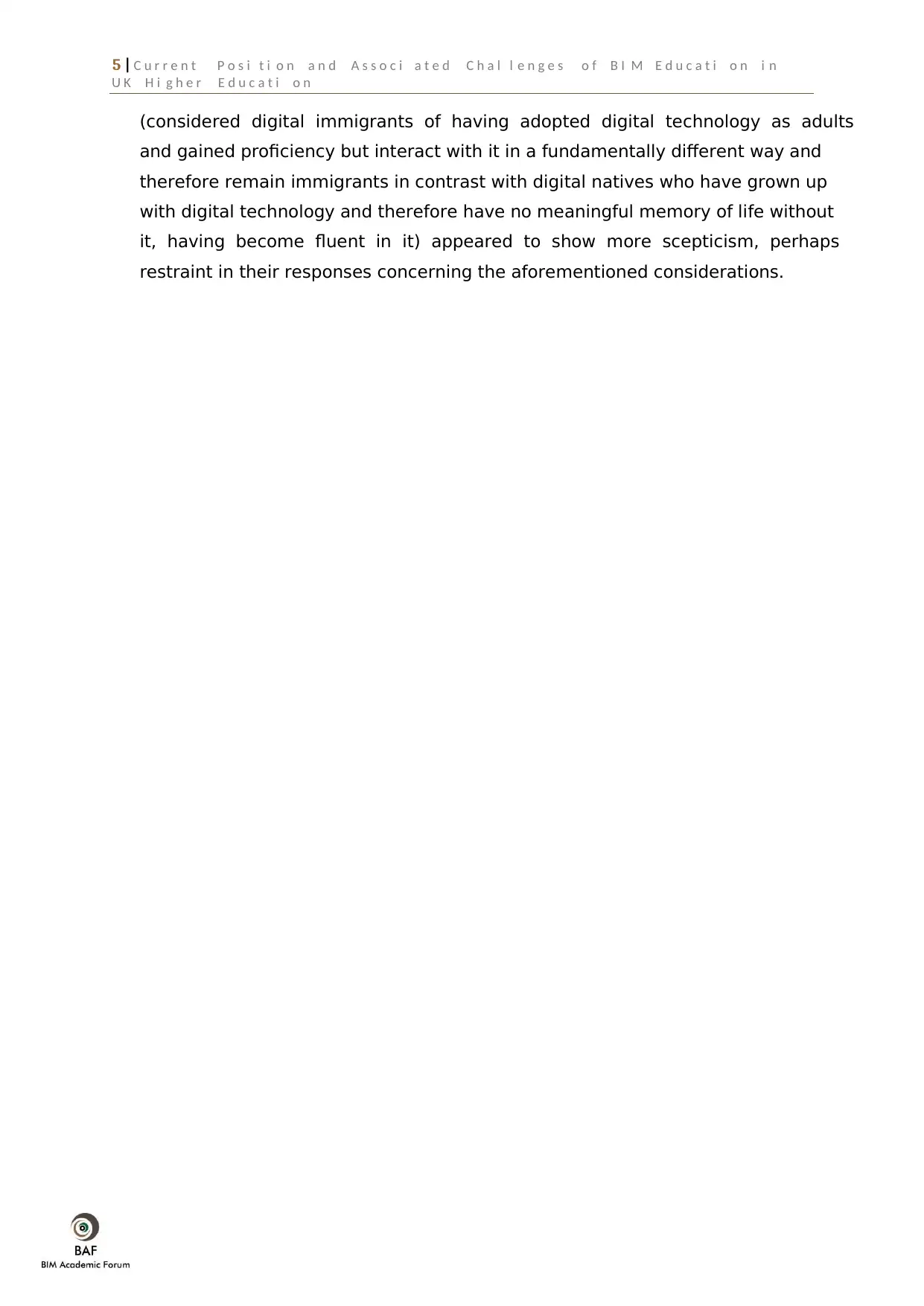
5 | C u r r e n t P o s i t i o n a n d A s s o c i a t e d C h a l l e n g e s o f B I M E d u c a t i o n i n
U K H i g h e r E d u c a t i o n
(considered digital immigrants of having adopted digital technology as adults
and gained proficiency but interact with it in a fundamentally different way and
therefore remain immigrants in contrast with digital natives who have grown up
with digital technology and therefore have no meaningful memory of life without
it, having become fluent in it) appeared to show more scepticism, perhaps
restraint in their responses concerning the aforementioned considerations.
U K H i g h e r E d u c a t i o n
(considered digital immigrants of having adopted digital technology as adults
and gained proficiency but interact with it in a fundamentally different way and
therefore remain immigrants in contrast with digital natives who have grown up
with digital technology and therefore have no meaningful memory of life without
it, having become fluent in it) appeared to show more scepticism, perhaps
restraint in their responses concerning the aforementioned considerations.
Paraphrase This Document
Need a fresh take? Get an instant paraphrase of this document with our AI Paraphraser
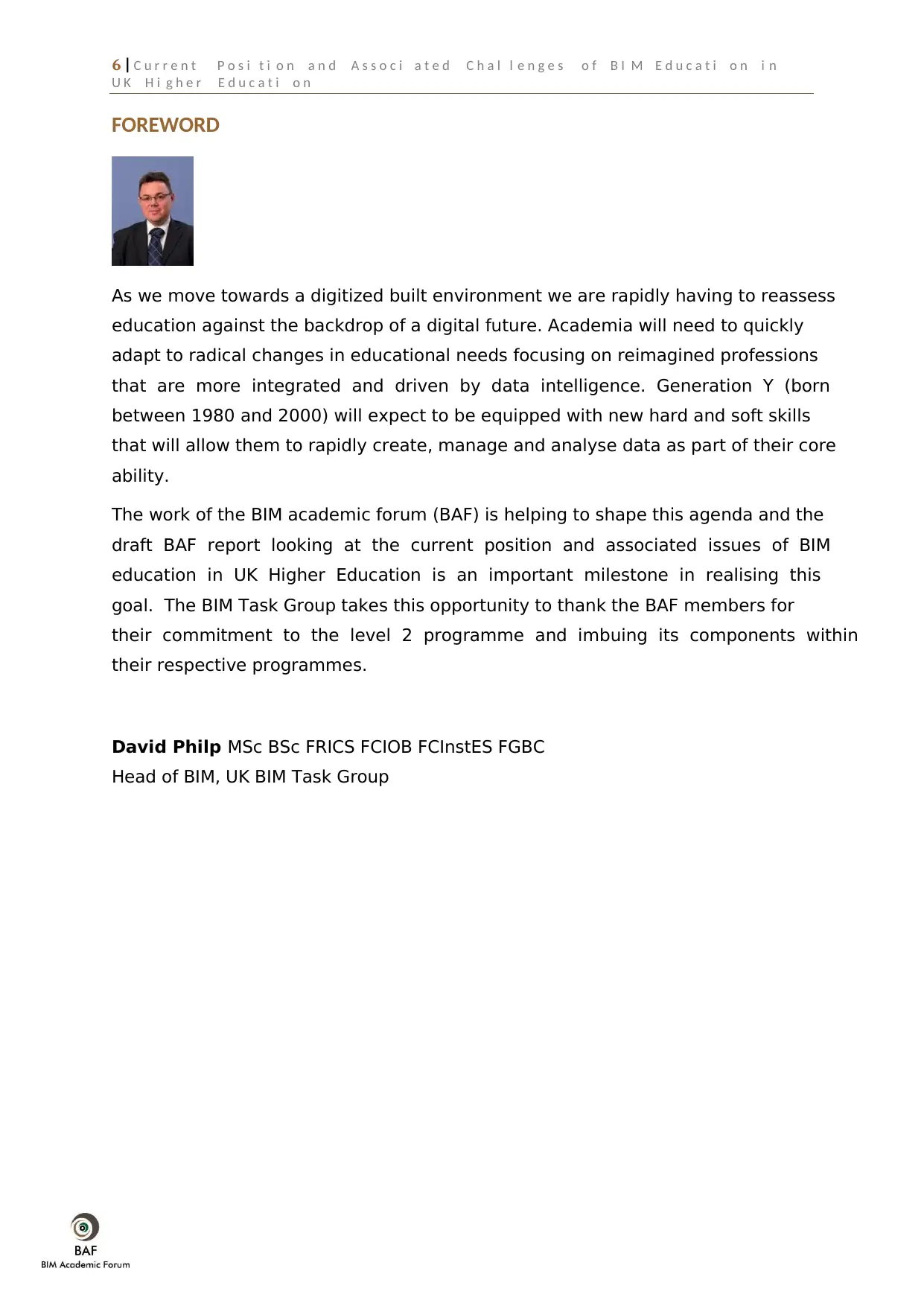
6 | C u r r e n t P o s i t i o n a n d A s s o c i a t e d C h a l l e n g e s o f B I M E d u c a t i o n i n
U K H i g h e r E d u c a t i o n
FOREWORD
As we move towards a digitized built environment we are rapidly having to reassess
education against the backdrop of a digital future. Academia will need to quickly
adapt to radical changes in educational needs focusing on reimagined professions
that are more integrated and driven by data intelligence. Generation Y (born
between 1980 and 2000) will expect to be equipped with new hard and soft skills
that will allow them to rapidly create, manage and analyse data as part of their core
ability.
The work of the BIM academic forum (BAF) is helping to shape this agenda and the
draft BAF report looking at the current position and associated issues of BIM
education in UK Higher Education is an important milestone in realising this
goal. The BIM Task Group takes this opportunity to thank the BAF members for
their commitment to the level 2 programme and imbuing its components within
their respective programmes.
David Philp MSc BSc FRICS FCIOB FCInstES FGBC
Head of BIM, UK BIM Task Group
U K H i g h e r E d u c a t i o n
FOREWORD
As we move towards a digitized built environment we are rapidly having to reassess
education against the backdrop of a digital future. Academia will need to quickly
adapt to radical changes in educational needs focusing on reimagined professions
that are more integrated and driven by data intelligence. Generation Y (born
between 1980 and 2000) will expect to be equipped with new hard and soft skills
that will allow them to rapidly create, manage and analyse data as part of their core
ability.
The work of the BIM academic forum (BAF) is helping to shape this agenda and the
draft BAF report looking at the current position and associated issues of BIM
education in UK Higher Education is an important milestone in realising this
goal. The BIM Task Group takes this opportunity to thank the BAF members for
their commitment to the level 2 programme and imbuing its components within
their respective programmes.
David Philp MSc BSc FRICS FCIOB FCInstES FGBC
Head of BIM, UK BIM Task Group
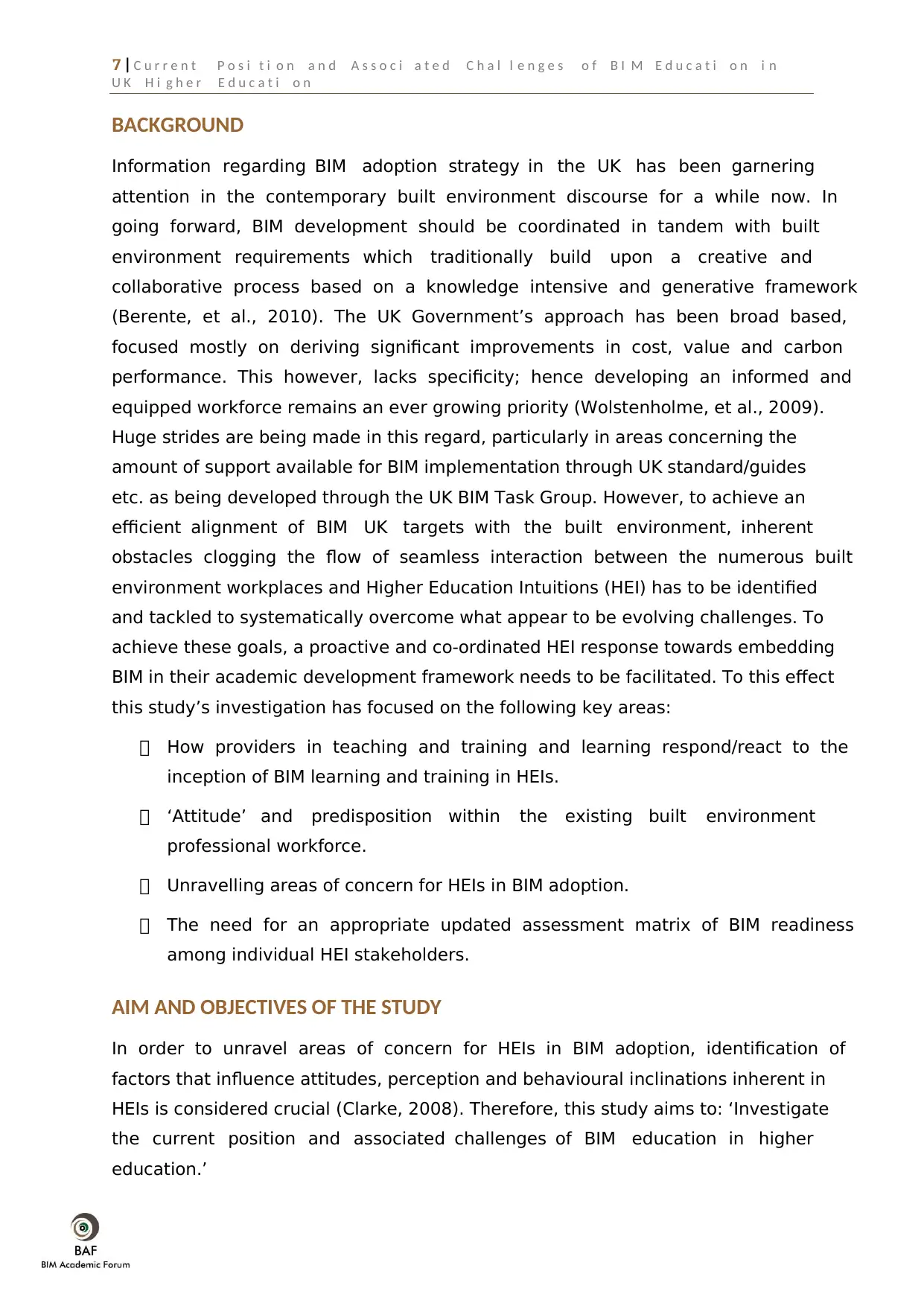
7 | C u r r e n t P o s i t i o n a n d A s s o c i a t e d C h a l l e n g e s o f B I M E d u c a t i o n i n
U K H i g h e r E d u c a t i o n
BACKGROUND
Information regarding BIM adoption strategy in the UK has been garnering
attention in the contemporary built environment discourse for a while now. In
going forward, BIM development should be coordinated in tandem with built
environment requirements which traditionally build upon a creative and
collaborative process based on a knowledge intensive and generative framework
(Berente, et al., 2010). The UK Government’s approach has been broad based,
focused mostly on deriving significant improvements in cost, value and carbon
performance. This however, lacks specificity; hence developing an informed and
equipped workforce remains an ever growing priority (Wolstenholme, et al., 2009).
Huge strides are being made in this regard, particularly in areas concerning the
amount of support available for BIM implementation through UK standard/guides
etc. as being developed through the UK BIM Task Group. However, to achieve an
efficient alignment of BIM UK targets with the built environment, inherent
obstacles clogging the flow of seamless interaction between the numerous built
environment workplaces and Higher Education Intuitions (HEI) has to be identified
and tackled to systematically overcome what appear to be evolving challenges. To
achieve these goals, a proactive and co-ordinated HEI response towards embedding
BIM in their academic development framework needs to be facilitated. To this effect
this study’s investigation has focused on the following key areas:
How providers in teaching and training and learning respond/react to the
inception of BIM learning and training in HEIs.
‘Attitude’ and predisposition within the existing built environment
professional workforce.
Unravelling areas of concern for HEIs in BIM adoption.
The need for an appropriate updated assessment matrix of BIM readiness
among individual HEI stakeholders.
AIM AND OBJECTIVES OF THE STUDY
In order to unravel areas of concern for HEIs in BIM adoption, identification of
factors that influence attitudes, perception and behavioural inclinations inherent in
HEIs is considered crucial (Clarke, 2008). Therefore, this study aims to: ‘Investigate
the current position and associated challenges of BIM education in higher
education.’
U K H i g h e r E d u c a t i o n
BACKGROUND
Information regarding BIM adoption strategy in the UK has been garnering
attention in the contemporary built environment discourse for a while now. In
going forward, BIM development should be coordinated in tandem with built
environment requirements which traditionally build upon a creative and
collaborative process based on a knowledge intensive and generative framework
(Berente, et al., 2010). The UK Government’s approach has been broad based,
focused mostly on deriving significant improvements in cost, value and carbon
performance. This however, lacks specificity; hence developing an informed and
equipped workforce remains an ever growing priority (Wolstenholme, et al., 2009).
Huge strides are being made in this regard, particularly in areas concerning the
amount of support available for BIM implementation through UK standard/guides
etc. as being developed through the UK BIM Task Group. However, to achieve an
efficient alignment of BIM UK targets with the built environment, inherent
obstacles clogging the flow of seamless interaction between the numerous built
environment workplaces and Higher Education Intuitions (HEI) has to be identified
and tackled to systematically overcome what appear to be evolving challenges. To
achieve these goals, a proactive and co-ordinated HEI response towards embedding
BIM in their academic development framework needs to be facilitated. To this effect
this study’s investigation has focused on the following key areas:
How providers in teaching and training and learning respond/react to the
inception of BIM learning and training in HEIs.
‘Attitude’ and predisposition within the existing built environment
professional workforce.
Unravelling areas of concern for HEIs in BIM adoption.
The need for an appropriate updated assessment matrix of BIM readiness
among individual HEI stakeholders.
AIM AND OBJECTIVES OF THE STUDY
In order to unravel areas of concern for HEIs in BIM adoption, identification of
factors that influence attitudes, perception and behavioural inclinations inherent in
HEIs is considered crucial (Clarke, 2008). Therefore, this study aims to: ‘Investigate
the current position and associated challenges of BIM education in higher
education.’
⊘ This is a preview!⊘
Do you want full access?
Subscribe today to unlock all pages.

Trusted by 1+ million students worldwide
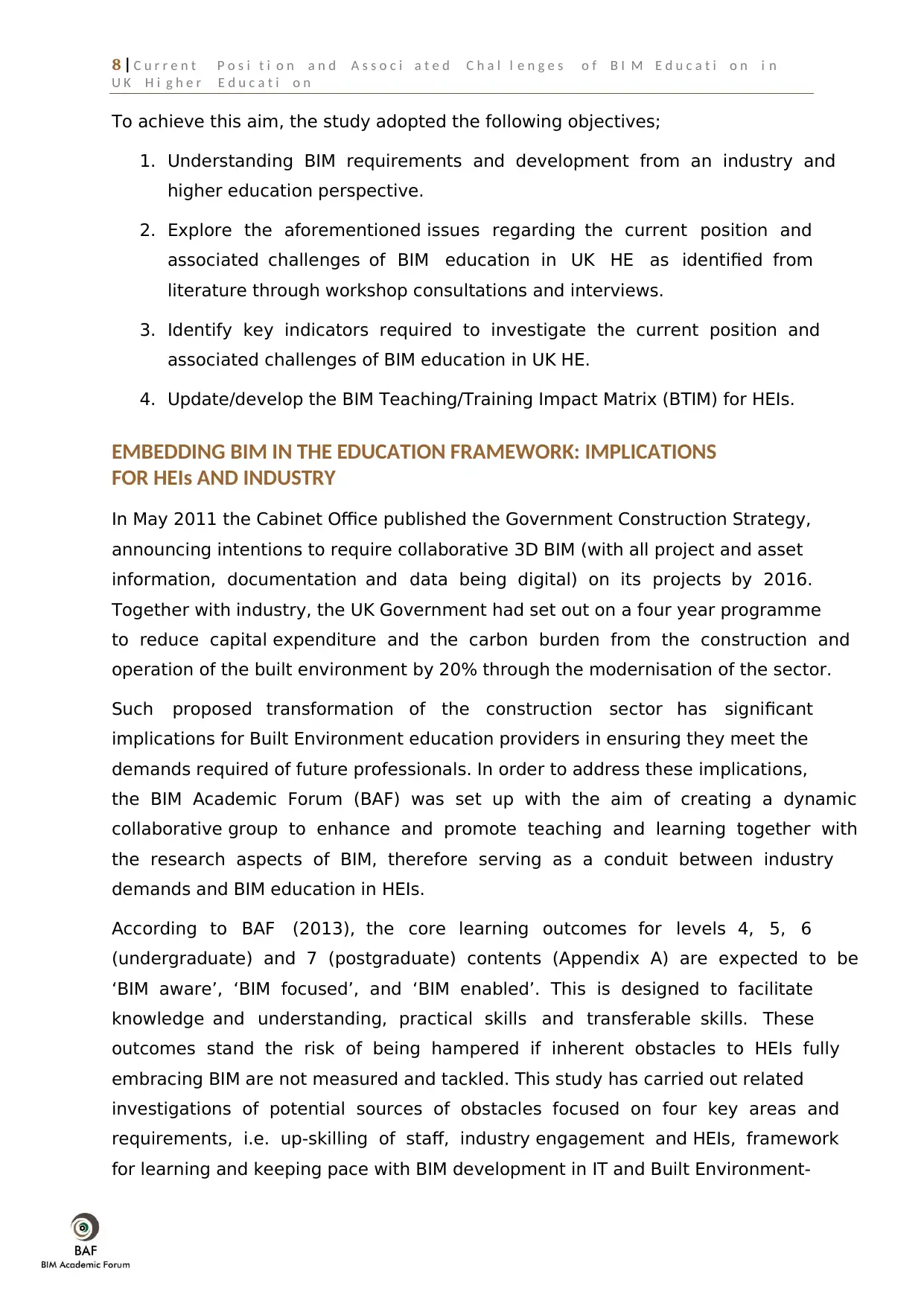
8 | C u r r e n t P o s i t i o n a n d A s s o c i a t e d C h a l l e n g e s o f B I M E d u c a t i o n i n
U K H i g h e r E d u c a t i o n
To achieve this aim, the study adopted the following objectives;
1. Understanding BIM requirements and development from an industry and
higher education perspective.
2. Explore the aforementioned issues regarding the current position and
associated challenges of BIM education in UK HE as identified from
literature through workshop consultations and interviews.
3. Identify key indicators required to investigate the current position and
associated challenges of BIM education in UK HE.
4. Update/develop the BIM Teaching/Training Impact Matrix (BTIM) for HEIs.
EMBEDDING BIM IN THE EDUCATION FRAMEWORK: IMPLICATIONS
FOR HEIs AND INDUSTRY
In May 2011 the Cabinet Office published the Government Construction Strategy,
announcing intentions to require collaborative 3D BIM (with all project and asset
information, documentation and data being digital) on its projects by 2016.
Together with industry, the UK Government had set out on a four year programme
to reduce capital expenditure and the carbon burden from the construction and
operation of the built environment by 20% through the modernisation of the sector.
Such proposed transformation of the construction sector has significant
implications for Built Environment education providers in ensuring they meet the
demands required of future professionals. In order to address these implications,
the BIM Academic Forum (BAF) was set up with the aim of creating a dynamic
collaborative group to enhance and promote teaching and learning together with
the research aspects of BIM, therefore serving as a conduit between industry
demands and BIM education in HEIs.
According to BAF (2013), the core learning outcomes for levels 4, 5, 6
(undergraduate) and 7 (postgraduate) contents (Appendix A) are expected to be
‘BIM aware’, ‘BIM focused’, and ‘BIM enabled’. This is designed to facilitate
knowledge and understanding, practical skills and transferable skills. These
outcomes stand the risk of being hampered if inherent obstacles to HEIs fully
embracing BIM are not measured and tackled. This study has carried out related
investigations of potential sources of obstacles focused on four key areas and
requirements, i.e. up-skilling of staff, industry engagement and HEIs, framework
for learning and keeping pace with BIM development in IT and Built Environment-
U K H i g h e r E d u c a t i o n
To achieve this aim, the study adopted the following objectives;
1. Understanding BIM requirements and development from an industry and
higher education perspective.
2. Explore the aforementioned issues regarding the current position and
associated challenges of BIM education in UK HE as identified from
literature through workshop consultations and interviews.
3. Identify key indicators required to investigate the current position and
associated challenges of BIM education in UK HE.
4. Update/develop the BIM Teaching/Training Impact Matrix (BTIM) for HEIs.
EMBEDDING BIM IN THE EDUCATION FRAMEWORK: IMPLICATIONS
FOR HEIs AND INDUSTRY
In May 2011 the Cabinet Office published the Government Construction Strategy,
announcing intentions to require collaborative 3D BIM (with all project and asset
information, documentation and data being digital) on its projects by 2016.
Together with industry, the UK Government had set out on a four year programme
to reduce capital expenditure and the carbon burden from the construction and
operation of the built environment by 20% through the modernisation of the sector.
Such proposed transformation of the construction sector has significant
implications for Built Environment education providers in ensuring they meet the
demands required of future professionals. In order to address these implications,
the BIM Academic Forum (BAF) was set up with the aim of creating a dynamic
collaborative group to enhance and promote teaching and learning together with
the research aspects of BIM, therefore serving as a conduit between industry
demands and BIM education in HEIs.
According to BAF (2013), the core learning outcomes for levels 4, 5, 6
(undergraduate) and 7 (postgraduate) contents (Appendix A) are expected to be
‘BIM aware’, ‘BIM focused’, and ‘BIM enabled’. This is designed to facilitate
knowledge and understanding, practical skills and transferable skills. These
outcomes stand the risk of being hampered if inherent obstacles to HEIs fully
embracing BIM are not measured and tackled. This study has carried out related
investigations of potential sources of obstacles focused on four key areas and
requirements, i.e. up-skilling of staff, industry engagement and HEIs, framework
for learning and keeping pace with BIM development in IT and Built Environment-
Paraphrase This Document
Need a fresh take? Get an instant paraphrase of this document with our AI Paraphraser
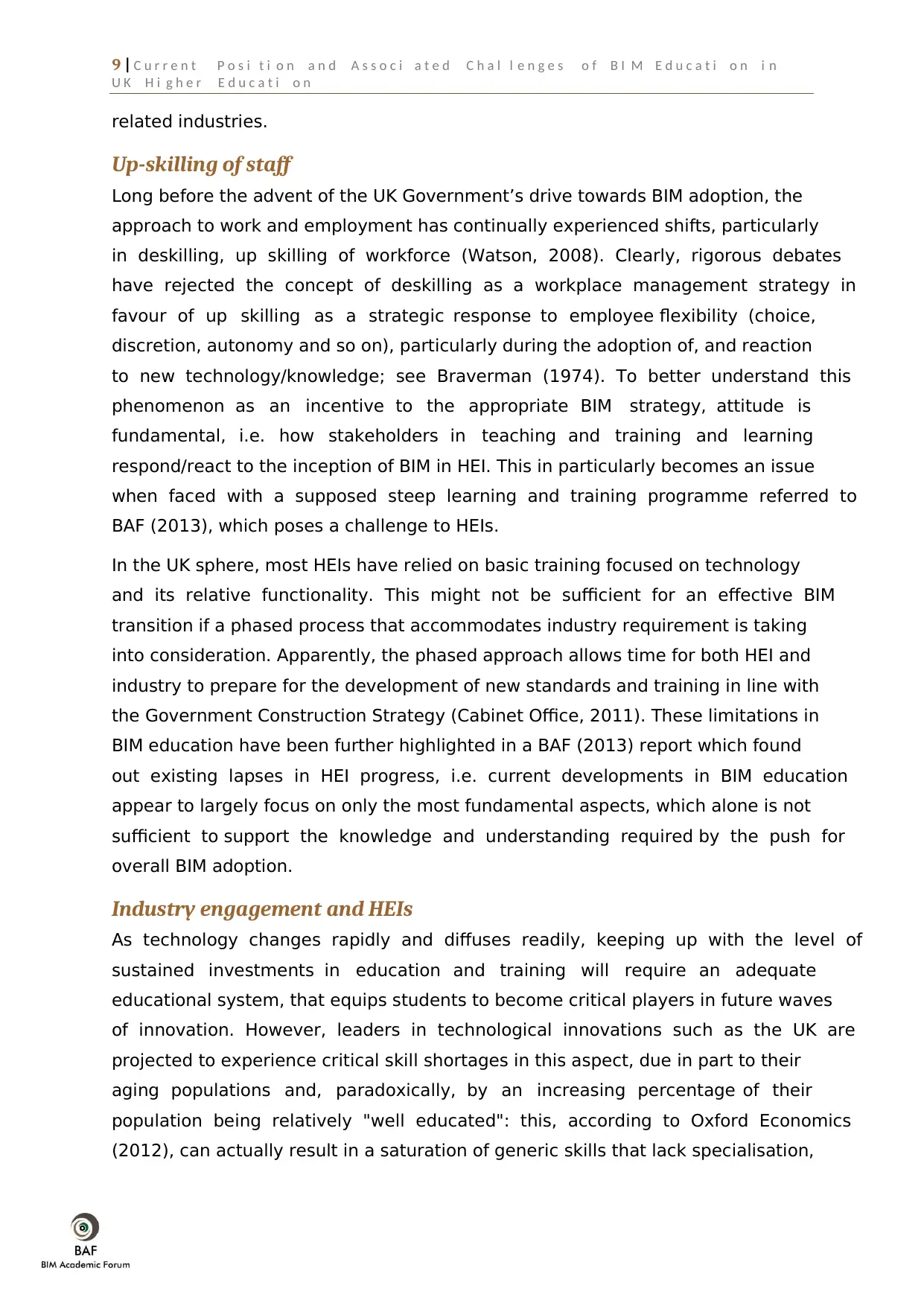
9 | C u r r e n t P o s i t i o n a n d A s s o c i a t e d C h a l l e n g e s o f B I M E d u c a t i o n i n
U K H i g h e r E d u c a t i o n
related industries.
Up-skilling of staff
Long before the advent of the UK Government’s drive towards BIM adoption, the
approach to work and employment has continually experienced shifts, particularly
in deskilling, up skilling of workforce (Watson, 2008). Clearly, rigorous debates
have rejected the concept of deskilling as a workplace management strategy in
favour of up skilling as a strategic response to employee flexibility (choice,
discretion, autonomy and so on), particularly during the adoption of, and reaction
to new technology/knowledge; see Braverman (1974). To better understand this
phenomenon as an incentive to the appropriate BIM strategy, attitude is
fundamental, i.e. how stakeholders in teaching and training and learning
respond/react to the inception of BIM in HEI. This in particularly becomes an issue
when faced with a supposed steep learning and training programme referred to
BAF (2013), which poses a challenge to HEIs.
In the UK sphere, most HEIs have relied on basic training focused on technology
and its relative functionality. This might not be sufficient for an effective BIM
transition if a phased process that accommodates industry requirement is taking
into consideration. Apparently, the phased approach allows time for both HEI and
industry to prepare for the development of new standards and training in line with
the Government Construction Strategy (Cabinet Office, 2011). These limitations in
BIM education have been further highlighted in a BAF (2013) report which found
out existing lapses in HEI progress, i.e. current developments in BIM education
appear to largely focus on only the most fundamental aspects, which alone is not
sufficient to support the knowledge and understanding required by the push for
overall BIM adoption.
Industry engagement and HEIs
As technology changes rapidly and diffuses readily, keeping up with the level of
sustained investments in education and training will require an adequate
educational system, that equips students to become critical players in future waves
of innovation. However, leaders in technological innovations such as the UK are
projected to experience critical skill shortages in this aspect, due in part to their
aging populations and, paradoxically, by an increasing percentage of their
population being relatively "well educated": this, according to Oxford Economics
(2012), can actually result in a saturation of generic skills that lack specialisation,
U K H i g h e r E d u c a t i o n
related industries.
Up-skilling of staff
Long before the advent of the UK Government’s drive towards BIM adoption, the
approach to work and employment has continually experienced shifts, particularly
in deskilling, up skilling of workforce (Watson, 2008). Clearly, rigorous debates
have rejected the concept of deskilling as a workplace management strategy in
favour of up skilling as a strategic response to employee flexibility (choice,
discretion, autonomy and so on), particularly during the adoption of, and reaction
to new technology/knowledge; see Braverman (1974). To better understand this
phenomenon as an incentive to the appropriate BIM strategy, attitude is
fundamental, i.e. how stakeholders in teaching and training and learning
respond/react to the inception of BIM in HEI. This in particularly becomes an issue
when faced with a supposed steep learning and training programme referred to
BAF (2013), which poses a challenge to HEIs.
In the UK sphere, most HEIs have relied on basic training focused on technology
and its relative functionality. This might not be sufficient for an effective BIM
transition if a phased process that accommodates industry requirement is taking
into consideration. Apparently, the phased approach allows time for both HEI and
industry to prepare for the development of new standards and training in line with
the Government Construction Strategy (Cabinet Office, 2011). These limitations in
BIM education have been further highlighted in a BAF (2013) report which found
out existing lapses in HEI progress, i.e. current developments in BIM education
appear to largely focus on only the most fundamental aspects, which alone is not
sufficient to support the knowledge and understanding required by the push for
overall BIM adoption.
Industry engagement and HEIs
As technology changes rapidly and diffuses readily, keeping up with the level of
sustained investments in education and training will require an adequate
educational system, that equips students to become critical players in future waves
of innovation. However, leaders in technological innovations such as the UK are
projected to experience critical skill shortages in this aspect, due in part to their
aging populations and, paradoxically, by an increasing percentage of their
population being relatively "well educated": this, according to Oxford Economics
(2012), can actually result in a saturation of generic skills that lack specialisation,
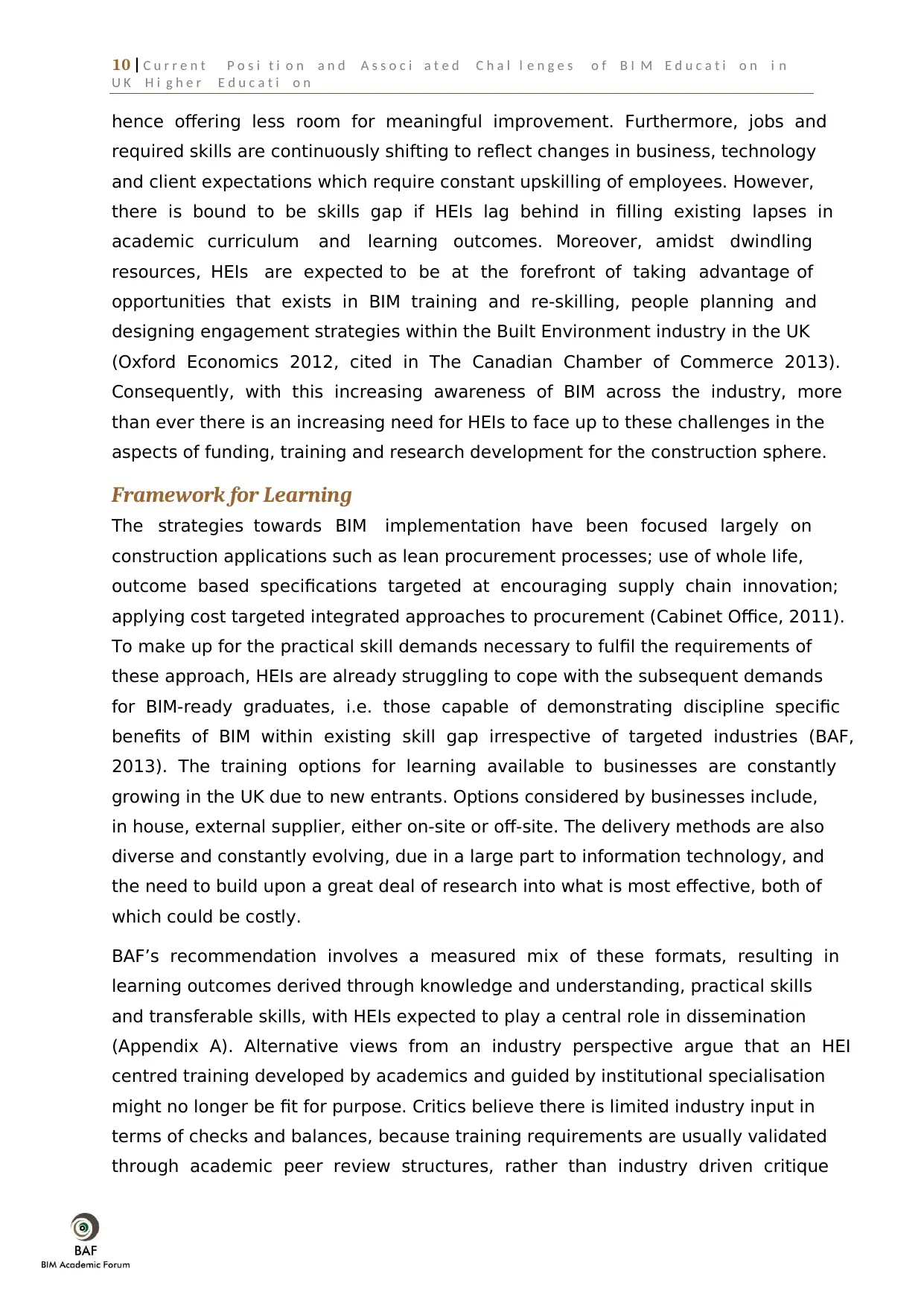
10 | C u r r e n t P o s i t i o n a n d A s s o c i a t e d C h a l l e n g e s o f B I M E d u c a t i o n i n
U K H i g h e r E d u c a t i o n
hence offering less room for meaningful improvement. Furthermore, jobs and
required skills are continuously shifting to reflect changes in business, technology
and client expectations which require constant upskilling of employees. However,
there is bound to be skills gap if HEIs lag behind in filling existing lapses in
academic curriculum and learning outcomes. Moreover, amidst dwindling
resources, HEIs are expected to be at the forefront of taking advantage of
opportunities that exists in BIM training and re-skilling, people planning and
designing engagement strategies within the Built Environment industry in the UK
(Oxford Economics 2012, cited in The Canadian Chamber of Commerce 2013).
Consequently, with this increasing awareness of BIM across the industry, more
than ever there is an increasing need for HEIs to face up to these challenges in the
aspects of funding, training and research development for the construction sphere.
Framework for Learning
The strategies towards BIM implementation have been focused largely on
construction applications such as lean procurement processes; use of whole life,
outcome based specifications targeted at encouraging supply chain innovation;
applying cost targeted integrated approaches to procurement (Cabinet Office, 2011).
To make up for the practical skill demands necessary to fulfil the requirements of
these approach, HEIs are already struggling to cope with the subsequent demands
for BIM-ready graduates, i.e. those capable of demonstrating discipline specific
benefits of BIM within existing skill gap irrespective of targeted industries (BAF,
2013). The training options for learning available to businesses are constantly
growing in the UK due to new entrants. Options considered by businesses include,
in house, external supplier, either on-site or off-site. The delivery methods are also
diverse and constantly evolving, due in a large part to information technology, and
the need to build upon a great deal of research into what is most effective, both of
which could be costly.
BAF’s recommendation involves a measured mix of these formats, resulting in
learning outcomes derived through knowledge and understanding, practical skills
and transferable skills, with HEIs expected to play a central role in dissemination
(Appendix A). Alternative views from an industry perspective argue that an HEI
centred training developed by academics and guided by institutional specialisation
might no longer be fit for purpose. Critics believe there is limited industry input in
terms of checks and balances, because training requirements are usually validated
through academic peer review structures, rather than industry driven critique
U K H i g h e r E d u c a t i o n
hence offering less room for meaningful improvement. Furthermore, jobs and
required skills are continuously shifting to reflect changes in business, technology
and client expectations which require constant upskilling of employees. However,
there is bound to be skills gap if HEIs lag behind in filling existing lapses in
academic curriculum and learning outcomes. Moreover, amidst dwindling
resources, HEIs are expected to be at the forefront of taking advantage of
opportunities that exists in BIM training and re-skilling, people planning and
designing engagement strategies within the Built Environment industry in the UK
(Oxford Economics 2012, cited in The Canadian Chamber of Commerce 2013).
Consequently, with this increasing awareness of BIM across the industry, more
than ever there is an increasing need for HEIs to face up to these challenges in the
aspects of funding, training and research development for the construction sphere.
Framework for Learning
The strategies towards BIM implementation have been focused largely on
construction applications such as lean procurement processes; use of whole life,
outcome based specifications targeted at encouraging supply chain innovation;
applying cost targeted integrated approaches to procurement (Cabinet Office, 2011).
To make up for the practical skill demands necessary to fulfil the requirements of
these approach, HEIs are already struggling to cope with the subsequent demands
for BIM-ready graduates, i.e. those capable of demonstrating discipline specific
benefits of BIM within existing skill gap irrespective of targeted industries (BAF,
2013). The training options for learning available to businesses are constantly
growing in the UK due to new entrants. Options considered by businesses include,
in house, external supplier, either on-site or off-site. The delivery methods are also
diverse and constantly evolving, due in a large part to information technology, and
the need to build upon a great deal of research into what is most effective, both of
which could be costly.
BAF’s recommendation involves a measured mix of these formats, resulting in
learning outcomes derived through knowledge and understanding, practical skills
and transferable skills, with HEIs expected to play a central role in dissemination
(Appendix A). Alternative views from an industry perspective argue that an HEI
centred training developed by academics and guided by institutional specialisation
might no longer be fit for purpose. Critics believe there is limited industry input in
terms of checks and balances, because training requirements are usually validated
through academic peer review structures, rather than industry driven critique
⊘ This is a preview!⊘
Do you want full access?
Subscribe today to unlock all pages.

Trusted by 1+ million students worldwide
1 out of 47
Your All-in-One AI-Powered Toolkit for Academic Success.
+13062052269
info@desklib.com
Available 24*7 on WhatsApp / Email
![[object Object]](/_next/static/media/star-bottom.7253800d.svg)
Unlock your academic potential
Copyright © 2020–2025 A2Z Services. All Rights Reserved. Developed and managed by ZUCOL.


